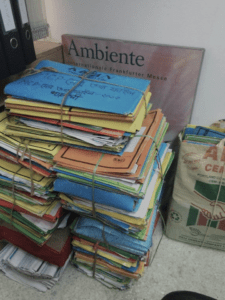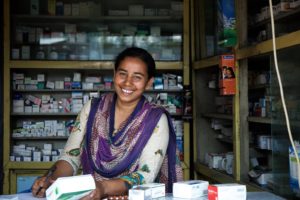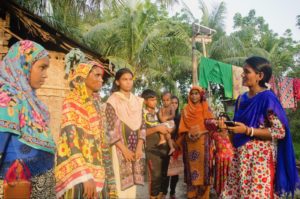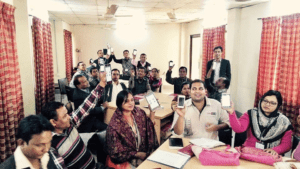
Search
June 19, 2018
Elaine Chang
When BRAC, one of the world’s largest NGOs, tried to digitize its paper-based record system to improve decision making and provide continuous improvement for its Skills Development Programme (SDP) in Bangladesh, it hit a wall.
SDP enables disadvantaged women and men to have better jobs by improving their skills, their income and their workplaces. It focuses on apprenticeship and entrepreneurship based interventions for the informal economy, enterprise development in the light engineering sector and building a pool of skilled professionals for Bangladesh’s increasingly capital intensive formal sector. As of 2018, over 60,000 youth, business owners and migrants have been reached with the goal of reaching half a million over the next few years. To achieve that scale, SDP needs to analyze their operations and results in a smart way to encourage continuous improvement of the program. BRAC had built other MIS systems so the SDP team took those into consideration in building their solution.
”Management wasn’t using those systems to really drive their decisions,” said Eshrat Waris, the manager of the Skills Development Programme, during a recent TaroWorks webinar. “After studying, (it) became clear those systems were being built for donor reporting…(but) it’s not where the data flows from. The data flows from the field.”

Image: Paper files BRAC used previously to store and manage field data. Source: BRAC
Hoping to make it easier to aggregate, analyze and act on large amounts of collected field data, Waris and her colleagues had also previously tried several data collection, analysis and decision-making approaches, including spreadsheets with macros. They discovered, however, that different versions of Excel in use by BRAC across the country created compatibility and performance issues.
The SDP team eventually turned to TaroWorks’ mobile field services management app and its offline Salesforce.com CRM to power a pilot project for 15 branches. The goal was to see if the use of mobile, digital tools could make data management more efficient and inform daily decisions to foster continuous improvement in operations.
View Webinar:
The new TaroWorks/Salesforce.com system was piloted for SDP’s Skills Training for Advancing Resources (STAR). STAR trains disadvantaged youth, especially women and people with disabilities, through on-the-job apprenticeships. The apprentices or learners are placed under a Master Craftsperson (MCP), who is an experienced shop owner or worker within a trade including tailoring, mobile phone servicing, refrigeration, aluminum fabrication and beauticians. Fifteen branches were selected for the pilot, which was run by a network of 2 Area Managers, 6 District Managers and 15 Programme Organizers. The front line field staff member, each Programme Organizer is responsible for an average of 56 learners. The 15 pilot branches had 1741 learners and 721 MCPs.
One of BRAC’s biggest challenges in using mobile technology and a cloud database to foster continuous improvement of apprenticeship program field operations was how these tools would meet the needs of the far-flung team of Programme Organizers.
“… it is a very much a field heavy operation and for us data was absolutely critical for understanding what was happening on the ground, to make decisions, to take decisions and to understand are we targeting the right people are we targeting the right trades,” said Waris during the webinar. “… we needed a technology where we were able to capture the data as things were happening in the field. We needed a real-time field operations management system and for us TaroWorks served that purpose.“

Image: The Skills Development Programme includes training in pharmacy. Source: BRAC
When Waris and her colleagues designed the system pilot, they wanted to make sure that it would be successfully adopted, so these were some of the design principles they followed:
When it came time to assess whether the pilot was successful or not, Waris realized that it wasn’t any particular indicator that proved success, but rather that all the participants were speaking up and offering ideas for new forms and new analysis. The system was on its way to being adopted and encouraging continuous improvement of operations. As a result, BRAC scaled the system from 15 to 141 branches overnight.
TaroWorks was used to create and administer mobile data collection surveys, digitize key elements of daily field management and identify trends or roadblocks through data visualization dashboards within Salesforce. As a result, BRAC was able to show continuous improvement in a number of areas including:

Image: TaroWorks being used on a smartphone at a learner’s house. Source: BRAC
Looking back on these and other examples of how TaroWorks and Salesforce technology helped produce and analyze data leading to continuous improvement of the program, Waris said:
“This is the impact we saw from our operations side – how we are using the data at every level to drive the data back into the operation design and really improve our productivity and our efficiency and our effectiveness as much as possible.”
With the mobile technology pilot program completed, BRAC learned important lessons, which helped it expand TaroWorks and Salesforce use across all of its field operations in Bangladesh.

Image: BRAC team members during a TaroWorks training session. Source: BRAC
Many TaroWorks customers previously used paper and spreadsheets to collect data, analyze metrics and run field operations. Let us show you how TaroWorks’ offline mobile field service app can help scale your business by digitizing sales and supply chain management, increasing agent network productivity and analyzing data in real-time for business insights.
POST TOPICS
Sign up to receive emails with TaroWorks news, industry trends and best practices.
TaroWorks, a Grameen Foundation company.
Site by V+V